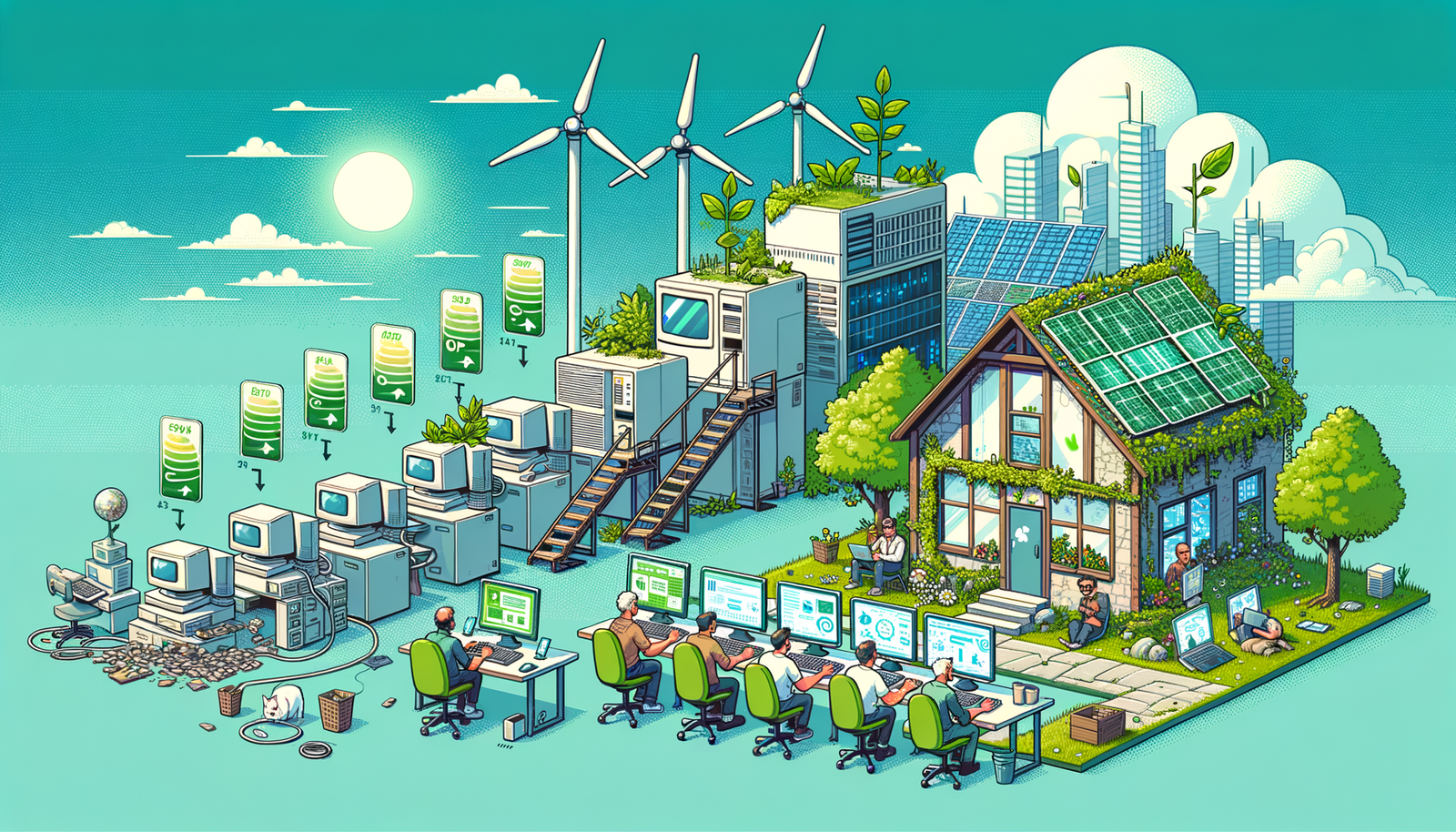Your Cart is Empty
Customer Testimonials
-
"Great customer service. The folks at Novedge were super helpful in navigating a somewhat complicated order including software upgrades and serial numbers in various stages of inactivity. They were friendly and helpful throughout the process.."
Ruben Ruckmark
"Quick & very helpful. We have been using Novedge for years and are very happy with their quick service when we need to make a purchase and excellent support resolving any issues."
Will Woodson
"Scott is the best. He reminds me about subscriptions dates, guides me in the correct direction for updates. He always responds promptly to me. He is literally the reason I continue to work with Novedge and will do so in the future."
Edward Mchugh
"Calvin Lok is “the man”. After my purchase of Sketchup 2021, he called me and provided step-by-step instructions to ease me through difficulties I was having with the setup of my new software."
Mike Borzage
Design Software History: Evolution of Sustainable Practices: Integrating Environmental Consciousness in Design Software Development
November 06, 2024 7 min read


The convergence of technology and environmental consciousness has become a pivotal focus in the modern era, especially within the realm of software development. As the global community grapples with the pressing issues of climate change and resource depletion, the importance of sustainability in software development cannot be overstated. Software not only drives innovation but also has the potential to significantly influence energy consumption and environmental impact across various industries. This is particularly true for design software, which plays a critical role in shaping the physical world through architectural plans, product designs, and engineering solutions.
Over the past few decades, design software has undergone a profound evolution, increasingly integrating environmental considerations into its core functionalities. From the early days of computer-aided design (CAD) systems to the sophisticated modeling and simulation tools of today, there has been a growing recognition of the need to incorporate sustainability into design processes. This evolution is a response to both technological advancements and a heightened awareness of the environmental implications of design decisions. The software industry has begun to acknowledge that sustainability is not just a peripheral concern but a central component of responsible innovation.
This article delves into the key developments and trends that have shaped sustainable practices within design software. By examining the historical context, we can understand how early awareness of environmental issues prompted initial steps towards sustainability. We will explore the innovations that have emerged, highlighting specific tools and frameworks that prioritize ecological considerations. Furthermore, we will analyze the challenges that persist and consider the future directions of sustainable design software. The aim is to provide a comprehensive overview that underscores the significance of integrating sustainability into the software that designs our world, ultimately fostering a more environmentally responsible approach to technology and innovation.
Historical Context of Sustainability in Software Development
In the early days of the tech industry, environmental considerations were often overshadowed by the rapid pace of innovation and the pursuit of technological advancement. However, as early as the 1970s and 1980s, there was a burgeoning awareness of the environmental impact of technology production and usage. Pioneering figures like Amory Lovins, founder of the Rocky Mountain Institute, began advocating for energy efficiency and sustainable practices in various industries, including technology. This period marked the initial recognition that the burgeoning digital revolution had a significant ecological footprint that needed to be addressed.
As environmental awareness grew, software companies started to take tentative steps towards integrating sustainability into their operations and products. In the 1990s, companies like Autodesk and IBM began exploring ways to make their software more energy-efficient and environmentally friendly. Autodesk, a leader in design software, initiated programs to educate designers about the environmental impacts of their projects, recognizing the influential role that their software played in shaping physical infrastructures and products. IBM, on the other hand, launched its Environmental Affairs Policy, focusing on reducing the environmental impact of its products and services, which included optimizing software for better energy efficiency.
The turn of the millennium saw significant milestones in the integration of sustainable practices within software engineering. The emergence of the Green Software Engineering discipline highlighted the industry's commitment to sustainability. This discipline focused on developing software that was not only efficient in terms of performance but also minimized energy consumption during execution. In 2007, the Green Grid consortium was formed by industry leaders like Intel, Microsoft, and Dell to improve energy efficiency in data centers and business computing ecosystems, emphasizing the role of software in achieving these goals.
Furthermore, the advent of the International Organization for Standardization's (ISO) 14000 family of standards provided guidelines for environmental management systems, which software companies began to adopt. This era also saw the incorporation of sustainability metrics into software development processes, with companies like Microsoft integrating environmental performance indicators into their product development lifecycles. The focus was not only on creating software that aided in sustainable design but also on ensuring that the software development processes themselves adhered to environmental best practices.
Innovations in Sustainable Design Software
The push for sustainability has led to significant innovations in design software, with tools increasingly incorporating environmental considerations as a core feature. One of the most impactful developments has been the integration of energy modeling software in architectural design. Companies like Autodesk and Bentley Systems have been at the forefront, developing software that enables architects and engineers to simulate and analyze the energy performance of buildings during the design phase. Autodesk's Revit software, for example, includes energy analysis tools that allow designers to assess factors such as insulation, window placement, and HVAC efficiency, leading to more sustainable building designs.
Another significant innovation is the development of simulation tools for assessing material efficiency. Software such as SolidWorks Sustainability by Dassault Systèmes provides designers with the capability to evaluate the environmental impact of materials and manufacturing processes. By inputting different materials and processes, designers can receive real-time feedback on carbon footprint, energy consumption, and other environmental metrics. This enables informed decision-making that prioritizes sustainability without compromising on product functionality or aesthetics. Key features of these tools include:
- Real-time environmental impact assessment during the design process.
- Comparison of materials and manufacturing processes for optimal sustainability.
- Integration with existing design workflows to minimize disruption.
Beyond specific tools, there has been a concerted effort to develop algorithms and frameworks that promote sustainable decision-making within design processes. The advent of Generative Design is a prime example. Generative design leverages algorithms and artificial intelligence to generate optimized design solutions based on specified constraints, including environmental factors. Autodesk's Fusion 360 employs generative design to help engineers create lightweight structures that use less material while maintaining strength and integrity, directly contributing to resource conservation.
Moreover, the development of Building Information Modeling (BIM) has revolutionized how sustainability is integrated into construction projects. BIM allows for comprehensive modeling of a building's lifecycle, enabling stakeholders to analyze and improve the environmental performance at every stage. Companies like Graphisoft with their software ARCHICAD, have incorporated sustainability assessment tools that facilitate collaboration among architects, engineers, and contractors to achieve green building standards such as LEED certification.
These innovations are supported by the work of organizations like the Green Software Foundation, which brings together industry leaders to collaborate on developing open-source tools and frameworks. The Foundation focuses on creating software that is not only efficient but also contributes to reducing carbon emissions. Their initiatives have spurred the adoption of sustainable practices across the industry, emphasizing the importance of collaboration in advancing sustainability goals.
Challenges and Future Directions
Despite the significant advancements in sustainable design software, numerous challenges persist that hinder the widespread adoption and effectiveness of these tools. One of the primary technical limitations is the computational intensity of advanced simulation and modeling software. High-fidelity simulations require substantial processing power, which can paradoxically lead to increased energy consumption in data centers and local machines. This presents a conundrum where the tools designed to promote sustainability inadvertently contribute to higher energy usage. Companies are striving to optimize their software for better performance efficiency, but the balance between computational demands and environmental impact remains a significant hurdle.
Another challenge is the adoption hurdles faced by professionals in integrating sustainable practices into their workflows. Many designers and engineers are accustomed to traditional methods and may resist adopting new tools that require additional training or changes in their design process. The initial investment in software licenses and training can be a deterrent, especially for small firms with limited resources. Additionally, there is often a perceived trade-off between cost and ecological impact. Sustainable materials or design options might increase upfront costs, making it challenging to justify from a financial perspective. This industry resistance underscores the need for demonstrating the long-term economic benefits of sustainable design, such as:
- Reduced operational costs through energy-efficient designs.
- Compliance with environmental regulations avoiding penalties.
- Enhanced brand reputation leading to increased customer loyalty.
Looking towards the future, emerging technologies offer promising avenues for advancing sustainable practices in design software. The role of Artificial Intelligence (AI) is becoming increasingly significant. AI can enhance generative design processes, enabling more efficient exploration of sustainable design alternatives. Companies like Nvidia are developing AI frameworks that can predict and optimize energy consumption in designs, further integrating sustainability into the early stages of design. Additionally, cloud computing presents opportunities to mitigate the computational challenges associated with complex simulations. By leveraging cloud-based resources, designers can offload processing tasks to more energy-efficient data centers, reducing the environmental impact of local hardware usage.
An emerging trend is the adoption of Blockchain technology to improve transparency and traceability in sustainable supply chains. Software solutions incorporating blockchain can enable designers to verify the origin and environmental credentials of materials, promoting responsible sourcing practices. Furthermore, the integration of Internet of Things (IoT) devices with design software allows for real-time data feedback on environmental performance, enabling continuous improvement throughout a product's lifecycle.
Collaboration between technology companies, such as the partnership between Siemens and PTC to develop integrated digital solutions, exemplifies the move towards platforms that prioritize sustainability. These collaborations aim to create ecosystems where data flows seamlessly between different tools, enhancing the ability to design sustainably across disciplines. The future direction points towards holistic solutions that not only provide powerful design capabilities but also embed sustainability as a fundamental parameter.
Conclusion
In conclusion, the integration of sustainability into design software represents a critical evolution in how technology influences the physical world. The significance of this integration lies not only in reducing the environmental impact of individual designs but also in shaping an industry-wide shift towards responsible innovation. As we have explored, the historical progression from initial awareness to sophisticated tools reflects a growing recognition that sustainability considerations are indispensable in software development and use. Design software has the unique capability to influence multiple industries—architecture, engineering, manufacturing, and more—by embedding environmental considerations at the very inception of the design process.
It is imperative for developers and organizations to further prioritize sustainability within the tech industry. Software developers are in a pivotal position to create tools that not only meet the demands of performance and efficiency but also actively contribute to environmental stewardship. Organizations must invest in the development and adoption of these tools, providing the necessary training and resources to overcome adoption hurdles. By fostering a culture that values sustainability, the industry can drive meaningful change that extends beyond software and into the tangible world.
Looking ahead, the vision is for design software to be a catalyst for a more environmentally responsible approach to innovation. This entails embracing emerging technologies like AI and cloud computing to enhance sustainability features while minimizing unintended environmental impacts. It means creating collaborative ecosystems where data and tools work seamlessly to optimize designs for ecological benefits. Ultimately, the goal is for sustainability to be an intrinsic aspect of all design considerations, leading to products and infrastructures that harmonize technological advancement with environmental preservation.
Also in Design News

Cinema 4D Tip: Hand-Painted Vertex Maps — Fast Workflow for Deformers, MoGraph, and Material Masks
December 31, 2025 2 min read
Read More
V-Ray Tip: Efficient Motion Blur: Tune the Image Sampler Before Increasing Motion Subdivisions
December 31, 2025 2 min read
Read MoreSubscribe
Sign up to get the latest on sales, new releases and more …



